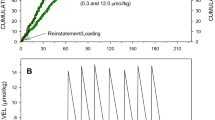Abstract
Rats were trained to discriminate phenobarbital (50 mg/kg) vs saline in a two-bar, thirst-motivated operant drug discrimination task. Presses on bar 1 were reinforced when the rat was drugged and presses on bar 2 when not drugged. Several shaping procedures and schedules of reinforcement were compared to determine which would allow drug discriminations to be learned most rapidly, and which would result in the higherst asymptotic accuracy of discrimination. The discrimination was learned more rapidly when differential drug conditions were used from the very first day of training than when shaping on both bars was completed before the differential drug conditions were introduced. Variable interval (VI), fixedratio (FR), and differential reinforcement of low rate (DRL) schedules were tested as well as several more complex schedules. Asymptotic accuracy of discrimination was highest when FR, interlocking FR 10/FI90″, or DRL 16″ schedules were used; accuracy was intermediate when a tandem VI 20″/FR 10 schedule was used; accuracy was relatively low when a VI 20″ schedule was employed. When the optimal shaping procedure and schedule of reinforcement were used, highly accurate drug discriminations were learned much more rapidly than has previously been reported. The results are discussed with reference to control of differential responding by contextual and discriminative stimuli.
Similar content being viewed by others
References
Appel, J. B., Kuhn, D. M., White, F. J.: Dual receptor mediation of the discriminative stimulus properties of pentazocine. In: Drug discrimination and state dependent learning, B. T. Ho, D. W. Richards III, D. L. Chute, eds., pp. 149–162. New York: Academic 1978
Colpaert, F. C.: Drug-induced cues and states: Some theoretical and methodological inferences. In: Discriminative stimulus properties of drugs, H. Lal ed., pp. 5–21. New York: Plenum 1977
Colpaert, F. C., Lal, H., Niemegeers, C. J. E., Janssen P. A. J.: Investigations on drug-produced and subjectively experienced discriminative stimuli: The fentanyl cue, a tool to investigate subjectively experienced narcotic drug acions. Life Sci. 16, 705–716 (1975)
Davidson, N. A., Osborne J. B.: Fixed-ratio and fixed-interval schedule control of matching-to-sample errors by children. J. Exp. Anal. Behav. 21, 27–36 (1974)
Ferster, C. B.: Intermittent reinforcement of matching-to-sample in the pigeon. J. Exp. Anal. Behav. 3, 259–272 (1960)
Holtzman, S. G., Shannon H. E. Schaefer, G. J.: Discriminative properties of narcotic antagonists. In: Discriminative stimulus properties of drugs, H. Lal, ed., pp. 47–72. New York: Plenum 1977
Kubena, R. K., Barry H. III: Generalization by rats of alcohol and atropine stimulus characteristics to other drugs. Psychopharmacologia (Berl.) 15, 196–206 (1969)
Kuhn D. M., Appel J. B., Greenberg I: An analysis of some discriminative properties of d-amphetamine. Psychopharmacologia (Berl.) 39, 57–66 (1974)
Kuhn, D. M., Greenberg, I., Appel, J. B.: Stimulus properties of the narcotic antagonist pentazocine: Similarity to morphine and antagonism by naloxone. J. Pharmacol. Exp. Ther. 196, 121–127 (1976)
Nevin J. A.: Effects of reinforcement scheduling on simultaneous discrimination performance. J. Exp. Anal. Behav. 10, 251–260 (1967)
Nevin, J. A., Cumming W. W., Berryman, R.: Ratio reinforcement of matching behavior. J. Exp. Anal. Behav. 6, 149–154 (1963)
Overton, D. A.: State-dependent or “dissociated” learning produced with pentobarbital. J. Comp. Physiol. Psychol. 57, 3–12 (1964)
Overton, D. A.: Discriminative control of behavior by drug states. In: Stimulus properties of drugs, T. Thompson, R. Pickens, eds., pp. 87–110. New York: Appleton-Century-Crofts 1971
Overton, D. A.: Experimental methods for the study of state-dependent learning. Fed. Proc. 33, 1800–1831 (1974)
Overton, D. A.: Comparison of ethanol, pentobarbital and phenobarbital using drug vs drug discrimination training. Psychopharmacology 53 195–199 (1977)
Overton, D. A.: Influence of training compartment design on performance in the two-bar drug discrimination task: A methodological report. In: Stimulus properties of drugs: Ten years of progress, C. F., Colpaert, J. A. Rosecrans, eds., pp. 265–278. Amsterdam: North Holland Biomedical 1978a
Overton, D. A.: Status of research on state dependent learning —1978. In: Stimulus properties of drugs: Ten years of progress, F. C. Colpaert, J. A. Rosecrans, eds. pp. 559–562 Amsterdam: North Holland Biomedical 1978b
Shannon, H. E., Holtzman, S. G.: Evaluation of the discriminative effects of morphine in the rat. J. Pharmacol. Exp. Ther. 198, 54–65 (1976)
Snapper, A. G., Kadden, R. M.: Time-sharing in a small computer based on a behavioral notation system. In: Digital computers in the behavioral laboratory, B. Weiss, ed., pp. 41–97. New York: Appleton-Centrury-Crofts 1970
Welker, R. L., Tomie A., Davitt, G. A., Thomas D. R.: Contextual stimulus control over operant responding in pigeons. J. Comp. Physiol. Psychol. 86, 549–562 (1974)
Williams, B. A.: Probability learning as a function of momentary reinforcement probability. J. Exp. Anal. Behav. 17, 363–368 (1972)
Winter, J. C.: Comparison of the stimulus properties of mescaline and 2,3,4-Trimethoxyphenylethylamine. J. Pharmacol. Exp. Ther. 185, 101–107 (1973)
Zeiler, M. D.: Stimulus control with fixed-ratio reinforcement. J. Exp. Anal. Behav. 11, 107–115 (1968)
Zeiler, M. D.: Fixed-interval stimulus control. J. Exp. Anal. Behav. 14, 291–299 (1970)
Zeiler, M. D.: Reinforcement of spaced responding in a simultaneous discrimination. J. Exp. Anal. Behav. 18, 443–451 (1972)
Zentall, T. R.: Effects of context change on forgetting in rats J. Exp. Psychol. 86, 440–448 (1970)
Author information
Authors and Affiliations
Rights and permissions
About this article
Cite this article
Overton, D.A. Influence of shaping procedures and schedules of reinforcement on performance in the two-bar drug discrimination task: A methodological report. Psychopharmacology 65, 291–298 (1979). https://doi.org/10.1007/BF00492218
Received:
Accepted:
Issue Date:
DOI: https://doi.org/10.1007/BF00492218




